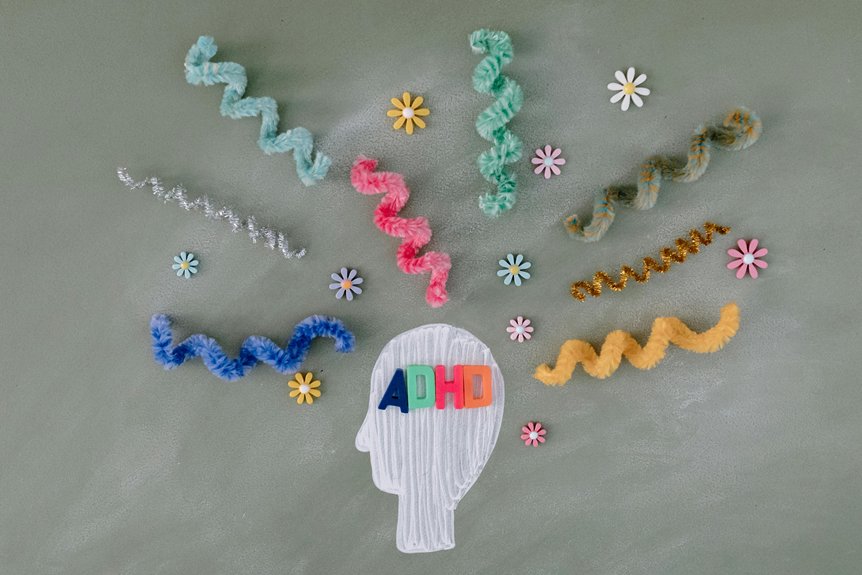The connection between the Patient Health Questionnaire (PHQ) and the Generalized Anxiety Disorder 7-item scale (GAD-7) is essential for understanding mental health. Both tools assess symptoms that often overlap, revealing how mood and anxiety disorders can coexist. By recognizing these links, you can better appreciate the complexities of mental health assessments. What happens when you apply both tools together? The implications for patient care could be significant.
Key Takeaways
- The Patient Health Questionnaire (PHQ) evaluates depressive symptoms, while the GAD-7 specifically assesses anxiety symptoms, highlighting their distinct focuses.
- Both tools can identify overlapping symptoms, aiding in the understanding of comorbid depression and anxiety in patients.
- Utilizing PHQ and GAD-7 together enhances diagnostic accuracy and treatment planning for individuals experiencing both conditions.
- Regular assessments with both questionnaires improve monitoring of treatment progress and patient engagement in mental health care.
- The dual assessment fosters open communication about mental health, encouraging patients to discuss their symptoms more comprehensively.
Overview of the Patient Health Questionnaire (PHQ)
The Patient Health Questionnaire (PHQ) serves as an essential tool in evaluating mental health, particularly focusing on depression and its symptoms.
Designed to streamline the diagnostic process, the PHQ purpose is to identify individuals struggling with various levels of depressive symptoms. When you complete the questionnaire, you’ll receive a score that reflects the severity of your depression.
PHQ scoring ranges from 0 to 27, with higher scores indicating more severe symptoms. By analyzing these results, healthcare providers can tailor treatment plans and interventions to better meet your needs, fostering a pathway toward improved mental well-being.
Overview of the Generalized Anxiety Disorder (GAD-7) Scale
Generalized Anxiety Disorder (GAD) can greatly impact daily functioning, making it essential to identify and assess its presence. The GAD-7 scale serves as a reliable tool in this anxiety assessment process. It evaluates GAD symptoms over the past two weeks, providing insight into their severity.
| GAD-7 Score | Interpretation |
|---|---|
| 0-4 | Minimal anxiety |
| 5-9 | Mild anxiety |
| 10-14 | Moderate anxiety |
| 15-21 | Severe anxiety |
Understanding your score can guide treatment decisions and help you manage anxiety more effectively.
Key Differences Between PHQ and GAD-7
While both the Patient Health Questionnaire (PHQ) and the GAD-7 are essential tools for evaluating mental health, they serve distinct purposes in evaluating different aspects of psychological well-being.
The PHQ primarily focuses on depressive symptoms, capturing how you feel over the past two weeks, while the GAD-7 hones in on anxiety symptoms, exploring your experiences over the last week.
These PHQ differences highlight the unique dimensions of mood disorders versus anxiety disorders. Additionally, understanding the GAD-7 nuances helps you identify specific anxiety triggers, allowing for tailored interventions.
Recognizing these distinctions can greatly enhance your mental health assessment and treatment journey.
How PHQ and GAD-7 Complement Each Other
Understanding how the Patient Health Questionnaire (PHQ) and the GAD-7 complement each other can greatly enhance your mental health assessment.
These complementary assessments provide a thorough view of your mental well-being, allowing for a more accurate dual diagnosis of depression and anxiety. When used together, they help identify overlapping symptoms, guiding you and your healthcare provider in tailoring effective treatment plans.
The PHQ focuses on depressive symptoms, while the GAD-7 hones in on anxiety. This synergy not only fosters a deeper understanding of your experience but also improves the quality of care you receive, ensuring a more holistic approach to mental health.
The Importance of Dual Assessment in Mental Health
Understanding the importance of dual assessment in mental health can considerably enhance your treatment journey.
By evaluating comorbid conditions alongside anxiety or depression, you’re likely to see better treatment outcomes and a more streamlined approach to care.
This thorough method not only addresses symptoms more effectively but also fosters a deeper connection between you and your healthcare provider.
Assessing Comorbid Conditions
Recognizing the interplay between mental health conditions is essential for effective treatment, especially when evaluating comorbid conditions like depression and anxiety. A thorough comorbidity assessment helps you identify symptom overlap, informing your understanding of how these disorders interact.
When symptoms of anxiety and depression coexist, treatment strategies can become more complex, potentially complicating diagnosis and management. A dual approach enables you to address both conditions simultaneously, increasing the likelihood of positive outcomes.
Enhancing Treatment Outcomes
The interplay between anxiety and depression can greatly impact treatment effectiveness, underscoring the need for a dual assessment approach in mental health care.
By evaluating both conditions simultaneously, you can identify tailored treatment strategies that address the complexities of your mental health. This thorough perspective not only enhances your understanding of symptoms but also fosters patient engagement, encouraging you to actively participate in your treatment plan.
Evidence shows that when both anxiety and depression are treated together, outcomes improve considerably, leading to better overall mental health and increased satisfaction with care.
Embracing dual assessment can truly transform your recovery journey.
Streamlining Patient Care
When you prioritize dual assessment in mental health care, you’re not just streamlining patient care; you’re enhancing your overall treatment experience.
By integrating tools like the Patient Health Questionnaire and General Anxiety Disorder assessment, you boost patient engagement and guarantee thorough understanding of symptoms. This approach fosters effective care coordination, allowing you to address both depression and anxiety simultaneously.
It also empowers you to create tailored treatment plans, improving outcomes. Patients feel heard and valued, which can increase adherence to treatment.
Ultimately, dual assessment not only simplifies processes but also enriches the therapeutic relationship, leading to better mental health outcomes.
Real-World Applications of PHQ and GAD-7 in Clinical Settings
In clinical settings, the PHQ and GAD-7 serve as essential screening tools for identifying mental health concerns early.
Their effectiveness in monitoring treatment progress allows you to adjust interventions based on real-time data, enhancing patient care.
Understanding how to implement these questionnaires can greatly improve outcomes for those struggling with anxiety and depression.
Screening Tool Utility
While clinicians face the challenge of accurately evaluating mental health in patients, tools like the Patient Health Questionnaire (PHQ) and Generalized Anxiety Disorder 7-item scale (GAD-7) prove invaluable in real-world settings.
These screening tools enhance diagnostic accuracy and offer significant screening benefits, allowing you to identify mental health concerns efficiently.
Here are four practical applications:
- Early detection of depressive and anxiety symptoms.
- Tailored treatment planning based on specific scores.
- Monitoring symptom severity over time.
- Facilitating open conversations about mental health with patients.
Utilizing these tools can foster a supportive environment for patient care and recovery.
Treatment Monitoring Effectiveness
Building on the utility of the Patient Health Questionnaire (PHQ) and the Generalized Anxiety Disorder 7-item scale (GAD-7) as screening tools, their role in treatment monitoring is equally significant.
By regularly evaluating symptoms, you can gauge treatment adherence and encourage patient engagement. These tools provide valuable insights into your progress, allowing for timely adjustments in your care plan.
Research shows that consistent monitoring fosters a stronger therapeutic alliance, as it empowers you to take an active role in your mental health journey.
Ultimately, the PHQ and GAD-7 can enhance the effectiveness of interventions and improve overall outcomes.
Conclusion
To summarize, utilizing both the Patient Health Questionnaire and the Generalized Anxiety Disorder scale not only enhances your understanding of a patient’s mental health but also allows for more personalized care. By recognizing the interplay between depressive and anxiety symptoms, you can address comorbid conditions more effectively. This dual assessment approach fosters a thorough treatment plan, ultimately improving patient outcomes and promoting better mental well-being in those you care for.




